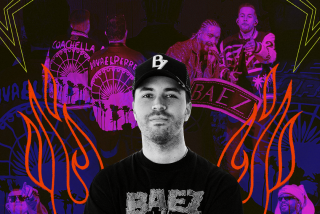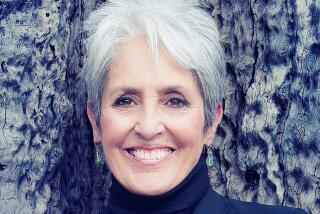Albert V. Baez, 94; physicist, father of Joan Baez
- Share via
Albert V. Baez, a physicist who did pioneering work with X-rays and who was the father of folk singers Joan Baez and the late Mimi Farina, has died. He was 94.
Baez, who also worked to improve science education worldwide, died of natural causes Tuesday in an elder-care facility in Redwood City, Calif., his family announced.
“In all aspects of his life, he combined personal and professional roles as scientist, environmentalist, teacher and humanitarian,” the Baez family said in a statement. “In doing so, he nurtured and conveyed values representing mankind at its best.”
Starting in the late 1940s, he helped lay the foundation for the newly developing science of X-ray imaging optics while doing graduate work in physics at Stanford University.
In 1948, working with Stanford professor Paul Kirkpatrick, Baez developed the first X-ray reflection microscope, which could examine living cells. The imaging technique is still used, particularly in astronomy to take X-ray pictures of galaxies and in medicine, said W. Gilbert Clark, a UCLA professor emeritus of physics and Kirkpatrick’s nephew.
As a University of Redlands professor in the 1950s, Baez continued developing X-ray technology but took a year off to teach and build a physics laboratory at the University of Baghdad in Iraq.
The Soviet launching of the Sputnik satellite in 1957 ignited a movement in the U.S. to improve science education -- a cause that came to dominate his career.
He helped make films aimed at improving the teaching of high school physics before being given a broader opportunity in 1961. The United Nations Educational, Scientific and Cultural Organization named him the first director of its science-teaching division.
Stationed in Paris until 1967, Baez helped developing nations improve their teaching of math and science.
“Science is one of the things needed in these countries if you’re going to have a base for a future economy. Otherwise they’ll always be the servants of the United States,” Baez wrote in an essay in the 1990 book “Mexican Voices/American Dreams.”
In retirement, he remained active, including serving as president of Vivamos Mejor (Let Us Live Better). The organization is dedicated to improving the quality of life through science-based education and community development projects in Latin America.
Albert Vinicio Baez was born Nov. 15, 1912, in Puebla, Mexico, and moved to Texas when he was 2.
His father, Alberto Baez, was a Methodist minister, and his mother, Thalia, became a social worker for the YWCA.
Baez grew up in Brooklyn, N.Y., and developed into a “bright, conscientious” boy who had “an insatiable curiosity about everything, especially the construction of crystal set radios,” Joan Baez wrote in her 1987 memoir, “And a Voice to Sing With.”
He earned a bachelor’s degree in math and physics from Drew University in 1933, a master’s in math from Syracuse University in 1935 and a doctorate in physics from Stanford in 1950. He taught at those universities and others, including UC Berkeley.
In 1958, after moving to a Boston suburb to teach at the Massachusetts Institute of Technology, he took Joan, then 17, to see a new phenomenon: coffeehouses filled with guitar players and folk balladeers, she wrote in her memoir. Within a year, the future folk star was onstage with them.
Another daughter, Mimi, saw her folk music career peak during her brief performance partnership with her husband, Richard Farina, who died in 1966. Mimi died in 2001.
Joan Baez admired her father -- a Quaker and pacifist -- for valuing teaching and turning away from potentially lucrative defense work.
“We would never have all the fine and useless things little girls want .... Instead we would have a father with a clear conscience,” she recalled in her memoir. “Decency would be his legacy to us.”
In addition to Joan Baez, he is survived by his wife, Joan Bridge Baez; another daughter, Pauline Bryan; three grandchildren; and a great-granddaughter.
*







